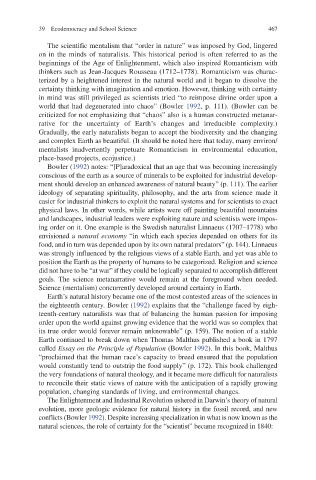Page 492 - Cultural Studies of Science Education
P. 492
39 Ecodemocracy and School Science 467
The scientific mentalism that “order in nature” was imposed by God, lingered
on in the minds of naturalists. This historical period is often referred to as the
beginnings of the Age of Enlightenment, which also inspired Romanticism with
thinkers such as Jean-Jacques Rousseau (1712–1778). Romanticism was charac-
terized by a heightened interest in the natural world and it began to dissolve the
certainty thinking with imagination and emotion. However, thinking with certainty
in mind was still privileged as scientists tried “to reimpose divine order upon a
world that had degenerated into chaos” (Bowler 1992, p. 111). (Bowler can be
criticized for not emphasizing that “chaos” also is a human constructed metanar-
rative for the uncertainty of Earth’s changes and irreducible complexity.)
Gradually, the early naturalists began to accept the biodiversity and the changing
and complex Earth as beautiful. (It should be noted here that today, many environ/
mentalists inadvertently perpetuate Romanticism in environmental education,
place-based projects, ecojustice.)
Bowler (1992) notes: “[P]aradoxical that an age that was becoming increasingly
conscious of the earth as a source of minerals to be exploited for industrial develop-
ment should develop an enhanced awareness of natural beauty” (p. 111). The earlier
ideology of separating spirituality, philosophy, and the arts from science made it
easier for industrial thinkers to exploit the natural systems and for scientists to exact
physical laws. In other words, while artists were off painting beautiful mountains
and landscapes, industrial leaders were exploiting nature and scientists were impos-
ing order on it. One example is the Swedish naturalist Linnaeus (1707–1778) who
envisioned a natural economy “in which each species depended on others for its
food, and in turn was depended upon by its own natural predators” (p. 144). Linnaeus
was strongly influenced by the religious views of a stable Earth, and yet was able to
position the Earth as the property of humans to be categorized. Religion and science
did not have to be “at war” if they could be logically separated to accomplish different
goals. The science metanarrative would remain at the foreground when needed.
Science (mentalism) concurrently developed around certainty in Earth.
Earth’s natural history became one of the most contested areas of the sciences in
the eighteenth century. Bowler (1992) explains that the “challenge faced by eigh-
teenth-century naturalists was that of balancing the human passion for imposing
order upon the world against growing evidence that the world was so complex that
its true order would forever remain unknowable” (p. 159). The notion of a stable
Earth continued to break down when Thomas Malthus published a book in 1797
called Essay on the Principle of Population (Bowler 1992). In this book, Malthus
“proclaimed that the human race’s capacity to breed ensured that the population
would constantly tend to outstrip the food supply” (p. 172). This book challenged
the very foundations of natural theology, and it became more difficult for naturalists
to reconcile their static views of nature with the anticipation of a rapidly growing
population, changing standards of living, and environmental changes.
The Enlightenment and Industrial Revolution ushered in Darwin’s theory of natural
evolution, more geologic evidence for natural history in the fossil record, and new
conflicts (Bowler 1992). Despite increasing specialization in what is now known as the
natural sciences, the role of certainty for the “scientist” became recognized in 1840:

